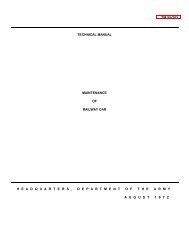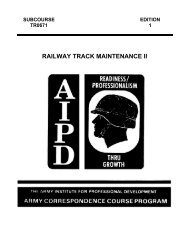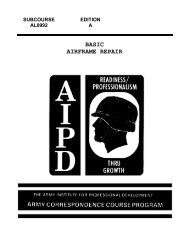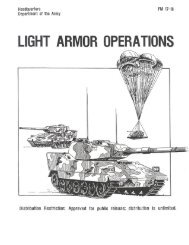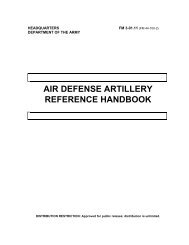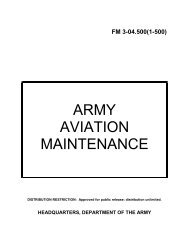fm 44-100 us army air and missile defense operations
fm 44-100 us army air and missile defense operations
fm 44-100 us army air and missile defense operations
Create successful ePaper yourself
Turn your PDF publications into a flip-book with our unique Google optimized e-Paper software.
PROCESS<br />
Appendix A<br />
Air Intelligence Preparation of the Battlefield<br />
This appendix describes the IPB process as it applies to AD <strong>operations</strong>.<br />
The breakup of the former Soviet Union has ca<strong>us</strong>ed the Army to shift its<br />
foc<strong>us</strong> from the Soviet threat to regional threats. With the current lack of a<br />
single well-defined threat to plan against, the IPB process will provide<br />
continuo<strong>us</strong> input toward defining that threat. Developing templates will<br />
be more challenging <strong>and</strong> more critical in support of the IPB process.<br />
A-1. FM 34-130 explains the IPB process in detail. The comm<strong>and</strong>er <strong>us</strong>es IPB<br />
to underst<strong>and</strong> the battlefield <strong>and</strong> the options it presents to friendly <strong>and</strong><br />
enemy forces. IPB is a systematic, continuo<strong>us</strong> process of analyzing the threat<br />
<strong>and</strong> environment in a specific area. By applying the IPB process, the<br />
comm<strong>and</strong>er gains the information necessary to selectively apply <strong>and</strong><br />
maximize his combat power at critical points in time <strong>and</strong> space on the<br />
battlefield. Airspace, or the aerial dimension, is the most dynamic <strong>and</strong> fast<br />
paced of the three dimensions. The intelligence staff m<strong>us</strong>t consider all the<br />
aspects of <strong>air</strong> <strong>operations</strong> <strong>and</strong> m<strong>us</strong>t be aware of the capabilities of all <strong>air</strong><br />
threats, to include UAVs, ballistic <strong>missile</strong>s, cruise <strong>missile</strong>s, ASMs, <strong>and</strong><br />
rotary- <strong>and</strong> fixed-wing <strong>air</strong>craft. The G2 <strong>and</strong> S2 have overall staff<br />
responsibility for IPB. ADA <strong>and</strong> aviation officers m<strong>us</strong>t provide input to the<br />
G2 <strong>and</strong> S2 when integrating <strong>air</strong> aspects into the IPB process.<br />
A-2. The IPB process has four steps:<br />
• Define the battlefield environment.<br />
• Describe the battlefield effects.<br />
• Evaluate the threat.<br />
• Determine threat courses of action.<br />
A-3. Since terrain, weather, <strong>and</strong> other characteristics of the battlefield have<br />
different effects on <strong>air</strong> <strong>operations</strong> <strong>and</strong> AMD <strong>operations</strong>, aerial IPB differs<br />
from ground IPB. Threat forces m<strong>us</strong>t be evaluated in relation to the effects<br />
that weather, terrain, <strong>and</strong> friendly <strong>operations</strong> will have on them. The most<br />
significant threats that m<strong>us</strong>t be evaluated for aerial IPB are UAVs, ballistic<br />
<strong>missile</strong>s, cruise <strong>missile</strong>s, <strong>and</strong> fixed- <strong>and</strong> rotary-wing <strong>air</strong>craft. Aerial IPB is an<br />
integral part of the IPB process at all levels.<br />
DEFINE THE BATTLEFIELD ENVIRONMENT<br />
A-4. The battlefield includes aerial dimensions in an area of <strong>operations</strong>,<br />
battlespace, <strong>and</strong> an area of interest. Beca<strong>us</strong>e of the aerial dimension, each of<br />
these parts of the battlefield framework may be different from that of ground<br />
force <strong>operations</strong>.<br />
A-1




